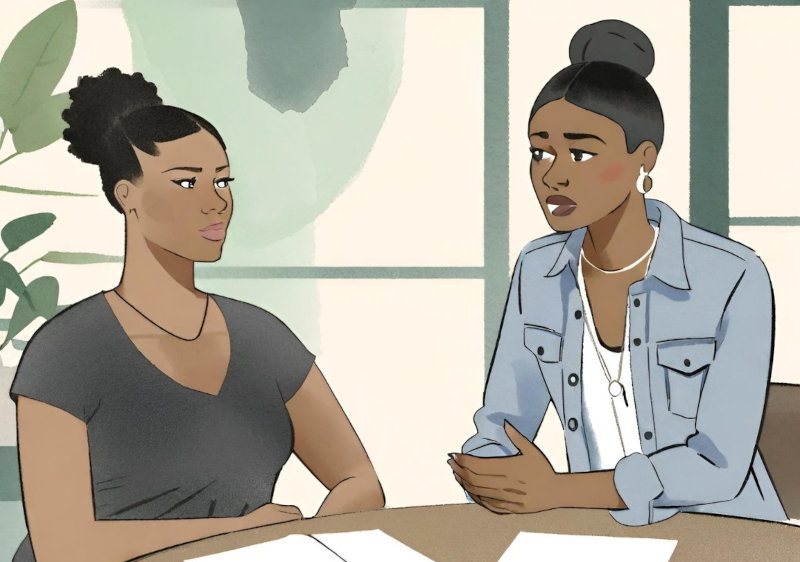By Christine Saari, MA, E-RYT, C-IAYT
A Guide for Clinicians
Connecticut’s Victim Compensation Program (VCP), managed by the Office of Victim Services (OVS), offers a multidimensional approach to support victims of violent crimes. An exciting and innovative facet of this program is its openness in providing victims with full reimbursement for integrative therapies not typically covered by insurance, such as yoga therapy.
Unlike generic yoga classes, yoga therapists undergo rigorous training specifically geared towards trauma recovery. Their methods aren’t just about trauma-sensitive care. Instead, yoga therapists actively facilitate trauma healing through personalized yoga practices. This evolving field is demonstrating immense potential in complementing traditional therapeutic interventions.
What’s even more noteworthy for clinicians is that, unlike most insurance programs, VCP makes yoga therapy fully accessible by covering its costs. Hence, therapists now have an additional, fully reimbursable tool in their toolkit to aid trauma survivors: individualized yoga therapy.
In this article, you’ll learn:
- about the impacts of violent crime in Connecticut;
- the role of yoga therapy in trauma recovery;
- what is the Victim Compensation Program;
- who and what is covered by the program;
- your role as a mental health professional in helping your client apply to the program;
- how to refer your client for yoga therapy;
- and what to do if you work outside of Connecticut.
The Silent Trauma of Violence in Connecticut
Connecticut, often touted for its relatively lower crime rates, carries a heavy, unseen burden – the traumatic aftermath of violence. Sexual violence, intimate partner violence, and domestic violence loom large, leaving indelible scars on both adults and children.
The Landscape of Violent Crime in Connecticut
While Connecticut has seen an overall decline in violent crime in recent years, positioning it well below the national average, the state’s crime landscape is complex and continues to deeply affect countless lives. By 2021, Connecticut’s violent crime rate was less than half the national average.1 Yet, these figures don’t tell the whole story. While many forms of crime have seen a downturn, areas like Hartford and New Haven witnessed decade-high murder rates. Additionally, there was a concerning uptick of 23% in the number of reported forcible rapes from 2020 to 2021.1 These figures indicate that while progress is evident, challenges persist, underscoring the importance of comprehensive interventions and support.
Sexual Violence
A deep-rooted issue that often goes unrecognized, sexual assault is the most prevalent yet under-reported crime in the US. Sexual violence goes beyond the immediate act. It resonates through the lives of its victims in the form of lasting physical and psychological consequences.
Distressingly, for many in Connecticut, this trauma begins early in life. A significant number face their first victimization before their 25th birthday, affecting nearly 1 in 5 girls and 1 in 14 boys.2 The implications of these experiences aren’t merely immediate. The Connecticut State Department of Public Health found that a staggering six out of ten victims of sexual assault grapple with serious psychological complications, such as depression and PTSD.3
These statistics don’t just represent numbers; they symbolize the heart-wrenching experiences of real individuals. They emphasize the urgency of providing holistic interventions and comprehensive support systems for survivors in our community.
Intimate Partner Violence (IPV)
In the arena of intimate partner violence (IPV), Connecticut’s figures raise alarm. IPV predominantly involves harm instigated by a current or ex-partner. This form of violence can emerge as physical harm, sexual violence, stalking, or psychological oppression.
The psychological repercussions of IPV are profound. A pivotal study by Fernández-Fillol et al. illuminates the insidious emergence of Complex Posttraumatic Stress Disorder (C-PTSD) among IPV survivors. This condition envelops both the classic PTSD symptoms and additional disturbances in self-organization. Distressingly, the study revealed that among IPV survivors, C-PTSD prevalence was 39.5%, significantly overshadowing the 17.9% exhibiting signs of PTSD.4
Domestic Violence
While IPV focuses on partner dynamics, domestic violence has broader ramifications. Beyond intimate relationships, domestic violence encompasses harm between family members, like parent-child conflicts or sibling disputes. Such violence, often concealed behind closed doors, can have long-lasting effects. These effects range from complex PTSD to anxiety disorders in the lives of its victims.
In the aftermath, victims often grapple with a compromised sense of safety that can alter healthy nervous system function, resulting in changes in the body’s physiology that can adversely impact physical health.
Demand Overwhelms Supply: The Growing Crisis in Trauma Mental Health Support
As violent and abusive incidents persist, so does the need for specialized mental health services for trauma recovery. Every statistic is a painful reminder of the real individuals behind the numbers, whether grappling with acute trauma and PTSD from singular violent episodes, complex trauma due to repeated exposure over time, or developmental trauma, affecting children during crucial growth phases and shaping their lifelong mental health.
Despite Connecticut’s relatively low crime rate, the need for related services vastly exceeds available resources, overwhelming many providers in the social services sector. The aftermath of the COVID-19 pandemic has deepened existing tensions, revealing entrenched economic, housing, and communal insecurities. As a result, the demand for mental health care has soared. This brings to light the enduring disparities often linked with violence and accentuating the systemic hurdles we confront.
Mental health clinicians and social services referral navigators are on the frontline. They bear the vital responsibility of providing healing and support, but many grapple with the strains of reduced resources as well as professional burnout.
The Victim Compensation Program offers a glimmer of hope. This initiative aids clinicians in meeting the growing demand for care, while making these essential services fully accessible to those who are most impacted by the layered nuances of trauma.
The Role of Yoga Therapy in Trauma Recovery
Yoga therapy’s strength lies in its tailored approach to the individual’s symptoms, recognizing that the impacts of trauma are not universally experienced. Every person’s encounter with trauma manifests in unique ways. This can materialize as emotional dysregulation, sleep disturbances, varied physical or psychological manifestations of anxiety, and a diminished connection to one’s body, sometimes evidenced by dissociative symptoms like memory lapses or feelings of disembodiment.
With these diverse challenges in mind, yoga therapy offers a nuanced response to each individual’s specific needs.
A Yoga Therapy Approach to Trauma Recovery
Drawing from ancient Yoga teachings and informed by advances in modern neuroscience, yoga therapy’s approach sits at the nexus of evidence-based care and traditional healing practices. The unique needs of the individual are considered from a holistic perspective.
Philosophical Foundations: The Yoga Perspective on Trauma Healing
Central to the therapeutic process in yoga therapy is its foundational philosophy: individuals are, by nature, whole and complete. The therapeutic journey is perceived not as a quest for external wholeness, but as a return to an inherent state of completeness that each individual intrinsically possesses. In this context, recovery is a reclamation of wholeness.
Guided by this philosophy, yoga therapy embarks on a three-fold path of healing for trauma survivors:
- Safety: First, safety is emphasized throughout the course of yoga therapy. This helps to establish a felt sense of security and healthy nervous system function.
- Agency: Then, the yoga practices encourage the client to develop a sense of agency by supporting autonomy through preference and choice-making.
- Reconnection: Finally, the practice facilitates reconnection to the self by building tolerance for present-moment awareness and sensations. Gentle, non-triggering practices cultivate inner awareness and concentration.
Explore more here for a deeper dive into the symptoms that yoga therapy addresses in trauma recovery.
Yoga Therapy’s Integration in Trauma Recovery Initiatives
The transformative power of yoga therapy in trauma recovery is backed up by a growing body of evidence that underscores its multifaceted benefits. Mounting clinical evidence continues to bear out these findings, positioning yoga therapy as an essential tool in trauma recovery.
As trauma reverberates through the cognitive and somatic dimensions of an individual — whether from exposure to violent crime or abuse — yoga therapy stands poised as a potential game-changer in elevating standards of care around trauma recovery.
While yoga therapy offers significant benefits, most insurance plans in Connecticut don’t cover it, making it financially challenging for many who need it most. This lack of coverage not only amplifies the existing barriers to accessing care, but also accentuates the systemic disparities and socioeconomic challenges often associated with violence exposure. This widens the chasm between those who can afford treatment and those left vulnerable.
As the impact of yoga therapy becomes increasingly evident and therapists see its tangible results, programs like Connecticut’s Victim Compensation Program play a critical role in bridging these barriers. It’s vital that mental health professionals are informed about the VCP’s coverage to seamlessly integrate yoga therapy into mainstream trauma treatment.
Integrating Yoga Therapy For Trauma Recovery Through Connecticut’s Victim Compensation Program
About the Victim Compensation Program
The Connecticut Office of Victim Services, which oversees administration of the Victim Compensation Program (VCP), was established within the Judicial Department in 2013. The Office’s primary role is to support and assist crime victims in various ways and to ensure that victims are informed, supported, and that their rights are upheld.
The VCP is funded through penalties and charges levied on those convicted of crimes, and through federal grants. The program can provide financial compensation to victims for eligible claims related to crime-related expenses that aren’t reimbursed or can’t be reimbursed by other sources.
Objective and Beneficiaries of the Victim Compensation Program
The Victim Compensation Program offers a crucial lifeline to victims of violent crimes in Connecticut, providing a comprehensive and empathetic approach to trauma recovery.
The program’s scope of beneficiaries is broad, ensuring that varying degrees and types of trauma are addressed. Visit the VCP website or contact the OVS to learn more about who may qualify for the Victim Compensation Program as well as a full list of eligibility criteria.
Coverage and Compensation
The VCP provides coverage in varying dollar amounts, depending on the eligibility criteria. For a full list of services that may be covered, visit the VCP website. Six months of bi-weekly yoga therapy typically costs between $2,000 and $3,000, which is often significantly less than allotted funds. This makes the VCP a financially viable coverage option for yoga therapy.
Special Provisions for Domestic Violence Victims
The VCP understands the sensitive nature of domestic violence and has set up guidelines to make it easier for victims to get help. Instead of only depending on police reports, victims can also talk to trained domestic violence counselors, get trauma-sensitive medical checks related to assault, or speak with professionals who know how to help in these situations. This ensures that getting help doesn’t add to the trauma they’ve already experienced.
Leveraging Social Services for VCP Applications
As clinicians, it’s crucial to be aware of the vast network of resources available to support victims of violent crimes. Beyond the immediate therapeutic interventions, there’s the vital aspect of helping clients access compensatory programs like the VCP. Here’s where social services organizations can be invaluable.
Social services organizations, like Family Centered Services of CT in New Haven, simplify the often daunting VCP application process for trauma victims. They offer tailored assistance, understanding the unique challenges each victim faces. Collaborating closely with therapists, they ensure a streamlined application process and often provide their expertise free of charge.
Getting the Word Out Among Therapists
Therapists in Connecticut have a vital role in promoting yoga therapy as a fully reimbursable complement to traditional trauma treatment through the VCP. Yet many remain unaware of its benefits.
The VCP presents a significant opportunity for clinicians to integrate this holistic approach. By advocating for yoga therapy, they can ensure victims of violent crimes receive comprehensive, cost-free care to further their healing journey.
Why Clinicians Should Consider Referring to Yoga Therapy
Navigating the complexities of mental health care demands an openness to diverse therapeutic modalities that cater to the individual nuances of each client. Yoga therapy, with its growing empirical support, presents a compelling case for inclusion alongside traditional therapeutic techniques.
At its essence, yoga therapy embraces a holistic framework, acknowledging the cognitive, physical, and spiritual realms of a given individual. Yoga therapists are uniquely positioned to expertly combine movement, breathwork, and meditation practices including mindfulness. These practices directly address the deep-seated interplay between the various aspects of the Self. This is especially beneficial for individuals who carry the weight of their trauma not just mentally, but also physically within their bodies.
Yoga Therapy as an Alternative to EMDR and Exposure Therapy
Unique to yoga therapy is its experiential essence. It provides a space for healing without the potentially triggering task of retelling trauma. Its intake remains conversational, making it a gentle alternative to more intrusive methods like exposure therapy or EMDR.
Though effective for many, exposure therapy and EMDR can feel intrusive or overwhelming to certain individuals. Some clients may display aversion or low compliance to such approaches,5 seeking alternatives that respect their boundaries and vulnerabilities. In these contexts, yoga therapy stands out as a compassionate alternative.
How to Make a Referral: Step-by-step
1: Identification of Need
Clients showcasing the following symptoms might be a prime candidate for yoga therapy:
- Heightened stress
- Physical tension
- Memory losses
- Disconnection from their body
- PTSD symptoms
- Difficulty with emotional regulation
- Talk therapy doesn’t seem to be working
- Aversion to re-experiencing or re-telling the trauma story
2: Initiate a Discussion
- Introduce the option of yoga therapy as an experiential, private, non-triggering approach.
- Highlight how yoga therapy can complement their current treatment plan.
- Provide an overview of the benefits.
- Address any barriers or concerns, emphasizing its suitability for absolute beginners to yoga practices, breathwork, or meditation.
- Discuss their financial options for paying for yoga therapy. Some clients may choose to pay upfront for yoga therapy and get reimbursed later if they qualify for the VCP.
3: Referral to Social Services for VCP Application
- Inform your client about the Victim Compensation Program (VCP).
- Refer to a local social services organization that assists victims of crimes in applying for the VCP, such as Family Centered Services of CT.
- Follow up with your client on the progress of their VCP application.
4: Providing Yoga Therapist Referral Options
- Direct your client to trusted sources, such as Yoga Therapy Associates.
- With your client’s permission, you can submit referrals for online yoga therapy in any state or in-person care in Connecticut to Yoga Therapy Associates via at referrals@yogatherapyassociates.com.
- Additionally, the International Association of Yoga Therapy offers a comprehensive platform to find certified yoga therapists.
5: Letter of Recommendation
- Submit a formal letter recommending yoga therapy as an adjuvant treatment for your client, referencing your client’s VCP application, addressed to the Office of Victim Services at: OVSCompensation@jud.ct.gov.
- Address the specific symptoms your client is facing as a result of the violent incident.
- Emphasize how yoga therapy can effectively address these symptoms.
6: Maintain Communication
- After initiating the yoga therapy sessions, stay in regular contact with your client.
- Monitor their progress and ensure the therapy aligns with their evolving needs.
Taking a collaborative approach to healing enriches the recovery journey. By combining traditional treatments with yoga therapy, clinicians provide a broader, more integrated spectrum of care to those healing from trauma.
For Clinicians Practicing Outside Connecticut
Considering the nationwide prevalence of sexual violence, IPV, and domestic violence, the necessity for holistic trauma recovery options has never been more evident, highlighting the urgent need for diversified therapeutic support in every state.
The Connecticut Victim Compensation’s coverage of yoga therapy for trauma recovery offers an exemplary model for addressing this need. However, many therapists and practitioners outside of Connecticut might remain unaware of similar opportunities in their regions.
Clinicians in other states are encouraged to explore local programs that may also provide inclusion of coverage for complementary therapeutic modalities like yoga therapy. Tapping into such resources can profoundly enhance the impact of traditional therapeutic methods.
As healing professionals nationwide, it’s our collective duty to stay informed about the untapped resources available in our communities for those on the path to recovery from trauma. By uniting in this endeavor, we emphasize the shared commitment of the mental health community to address this critical issue.
In Conclusion: The Path Forward
The cascading effects of violence and trauma are undeniable, permeating the very fabric of society and leaving countless individuals in their wake, searching for solace and recovery. Through the collective efforts of social service organizations, dedicated clinicians, yoga therapists, and groups such as Yoga Therapy Associates of New Haven, CT, victims are not only heard but holistically supported. Connecticut’s forward-thinking Victim Compensation Program, with its embracing of integrative modalities like yoga therapy, illuminates a trailblazing path toward holistic healing.
For mental health clinicians, the call to action is clear: to remain informed, collaborative, and proactive, leveraging every available resource to facilitate the profound journey of recovery for those they serve. The responsibility doesn’t end within the borders of one state; clinicians nationwide have the opportunity to champion innovative healing avenues, ensuring that every victim of violence has the chance to rediscover wholeness, resilience, and hope.
References
- McQuaid, H. (2022, December 15). State stats show most crime declined with exceptions. CT News Junkie. https://ctnewsjunkie.com/2022/12/15/state-stats-show-most-crime-declined-with-exceptions/
- Connecticut Department of Education. (2023). Section 1: Overview of sexual violence. Statewide K-12 Sexual Assault & Abuse Prevention & Awareness Program Guidelines. https://portal.ct.gov/SDE/Publications/Statewide-K12–Sexual-Assault-Abuse–Prevention-Awareness–Program-Guidelines/Section-1-Overview-of-Sexual-Violence
- Connecticut Department of Public Health. (2014). Healthy Connecticut 2020. CT.gov. https://portal.ct.gov/DPH/State-Health-Planning/Healthy-Connecticut-Archives/Healthy-Connecticut-2020–to-archive
- State of Connecticut Department of Children and Families. (2023). Intimate partner violence (IPV): Statistics. 2014. CT.gov. https://portal.ct.gov/DCF/Intimate-Partner-Violence/Home#Statistics
- Jaycox, L.H., and Foa, E.B. (1996). Obstacles in implementing exposure therapy for PTSD: Case discussions and practical solutions. Clinical psychology & psychotherapy, 3(3), 176-184. https://doi.org/10.1002/(SICI)1099-0879(199609)3:3<176::AID-CPP100>3.0.CO;2-1




